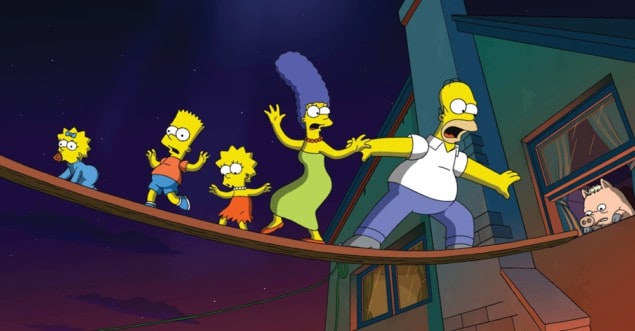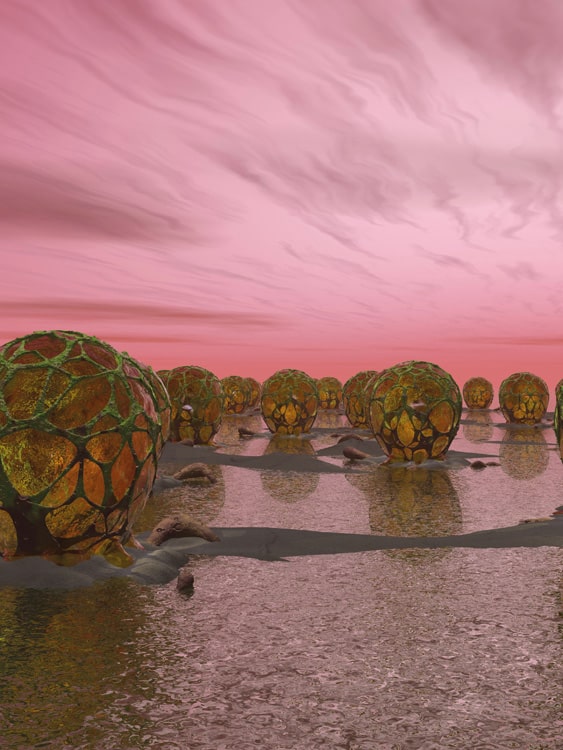Books about the mathematics in The Simpsons, vanishing starry nights, medical physics, big questions and some very weird life forms, reviewed by Tushna Commissariat, Margaret Harris and Sharon Ann Holgate

Mmm…mathematics
For most people, mathematics and the animated TV show The Simpsons are not exactly synonymous. Yet as the British science communicator Simon Singh shows in his book The Simpsons and their Mathematical Secrets, the show’s writers have stealthily inserted almost an entire PhD’s worth of mathematics into its 500+ episodes. This is partly a reflection of the writers’ backgrounds, since several of the show’s most prolific contributors acquired advanced mathematical degrees before changing careers. Writers David Cohen and Jeff Westbrook, for example, have degrees in physics and computer science, while Al Jean has a BSc in mathematics and was described as a “maths whizz” while a student at Harvard University. The popularity of The Simpsons has spawned a number of books that purport to examine the show’s psychology, politics, popular culture or religion; indeed, there is even a book devoted to the sometimes-impossible science of The Simpsons (What’s Science Ever Done for Us?: What the Simpsons Can Teach Us About Physics, Robots, Life, and the Universe by Paul Halpern). But as Singh shows, the show’s mathematical vein is actually quite deep. Its second episode, “Bart the genius”, features some clever calculus jokes at Bart Simpson’s expense, and from the offset the writers seemed keen to include high-brow hilarity in amongst the silliness and sight gags. Take, for example, the episode “The wizard of Evergreen Terrace”, in which Homer Simpson has a mid-life crisis and is inspired by Thomas Edison to become an inventor. It would be easy to miss the four equations that appear scribbled on a blackboard in this episode, but Singh – who must have worn out the “pause” button on his remote control while researching this book – shows that they include the equation that predicts the mass of the Higgs boson, a (near-miss) solution of Fermat’s last theorem and an equation for the expansion of the universe. Singh explains all of these concepts simply but clearly, and he also incorporates a set of five clever examinations so that you can test yourself. Undoubtedly, his book is the perfect Christmas present for both mathematical savants and Simpsons aficionados – not to mention anyone with a healthy interest in humour and maths.
- 2013 Bloomsbury Publishing £18.99/$26.00hb 272pp
No more starry nights

On a clear night, how many stars can you see in the sky above where you live? For most residents of developed countries (and cities everywhere), the answer is likely to be less than 100 – a far cry from the thousands that our ancestors saw 150 years ago, and that people who live in the world’s remaining dark-sky areas still experience today. Paul Bogard’s book The End of Night: Searching for Natural Darkness in an Age of Artificial Light is both a lament for those vanished starry nights and a tirade against the things that have caused their disappearance, including unshielded street lights, billboards lit from below and even squid-fishing boats, which use daylight-imitating spotlights to attract their prey. Bogard, a journalist at James Madison University in the US, has travelled around the world speaking to people with an interest in darkness, including astronomers, park rangers, philosophers and lighting engineers. Astronomers, in particular, have long been in the vanguard of the fight against light pollution, but Bogard shows that their concerns are only a small part of the big picture. As one of his interviewees puts it, “The presence of an astronomer [is] the sign of a healthy ecosystem…when the sky grows too bright for astronomy and the astronomers go away, you know you have a polluted sky, and whatever has polluted that sky will eventually pollute other resources, given time.” Accordingly, Bogard’s argument goes well beyond astronomy and aesthetics, taking in elements of ecology (light pollution is bad for animals), public health (people are animals too) and even social justice (poorer people are disproportionately affected). The book never quite decides whether it wants to be a poetic lament or a practical call to arms, but its mixture of lyricism and activism still makes for fascinating reading.
- 2013 Fourth Estate/Little, Brown £16.99/$27.00hb 366pp
A medical history lesson
Most physicists are familiar with the role that physics-based techniques such as magnetic resonance imaging, endoscopy and radiotherapy play in healthcare, but the story of how physics came to be an integral part of medicine is perhaps less well known. In Physicists and Physicians: a History of Medical Physics from the Renaissance to Röntgen, retired medical physicist Francis Duck describes the birth of his discipline via the life stories of the scientists and physicians who brought physics out of laboratories and into clinical practice and medical training. Duck has packed his book with interesting facts, quotes and illustrations from an array of pre-20th-century archive sources, some of which were previously unpublished. The medical content is simple enough for non-specialists to understand, although some descriptions of early medical physics experiments are rather stomach-churning. In one particularly gruesome 19th-century example, the vocal functions of the human larynx were probed with the deceased’s face still attached. Modern readers may also be startled by the many 18th-century attempts to use mild electric shocks for treating a wide range of conditions, including constipation, sprains and deafness – with varying degrees of success. Some of the medical-physics pioneers wrote popular-science books and, it seems, had a way with words; for example, an explanation of inertia in a book by the 19th-century British physician Neil Arnott included this delightful quote: “A horse at speed, stopping suddenly, often sends his cavalier over his ears.” The book contains several unnecessarily repeated quotes and a handful of rather jarring jumps from one topic to another, while most of the non-English book titles and institution names are left frustratingly un-translated. But Duck has an engaging writing tone, and physicists keen on history will not be disappointed by the depth of research or wealth of fascinating material presented.
- 2013 IPEM Books £35.00pb 306pp
Pondering the big stuff

What is the universe made of? Will we ever cure cancer? And where should we put all the carbon we are generating? These are just a few of the queries that feature in The Big Questions in Science: the Quest to Solve the Great Unknowns. The subject matter of this beautifully illustrated book reflects the diverse interests of its three authors; while all are British-based science writers, Hayley Birch specializes in writing about energy and the environment, while Mun Keat Looi and Colin Stuart focus on biomedicine and astronomy, respectively. The book’s 20 essays are written with clarity and verve, and the authors’ decision to include occasional sub-sections written by active researchers lends them extra gravitas. On the down side, the essays are too short to cover everything, and a few of the expert-penned sub-sections give a rather one-sided view of topics (such as string theory) that are still the subject of active scientific debate. In most cases, though, both the authors and their contributors are unafraid to say “we don’t know”, and the result is a fine introduction to important questions from across the scientific spectrum.
- 2013 Andre Deutsch £14.99hb 192pp
The weirdness starts here

Since the turn of the new millennium, planets orbiting stars other than our own have been discovered at an astounding rate: about one per fortnight, on average. This proliferation of new exoplanets has sparked renewed speculation about what, if anything, might be living on them. David Toomey’s book Weird Life: the Search for Life That Is Very, Very Different from Our Own offers an accessible and engaging survey of recent developments in the burgeoning field of exobiology. Toomey, a writer at the University of Massachusetts Amherst, US, begins by considering life that is “weird” in a biological sense. Our own planet, he explains, is home to numerous organisms that thrive in extremes of temperature, pressure, acidity or saltiness. So far, none of these so-called “extremophiles” has been shown to be truly weird (in the sense of having evolved independently from other terrestrial life), but research on them has nevertheless broadened our view of what constitutes a habitable planet. Next, Toomey contemplates the possibility of life that is based on substances other than carbon and liquid water – chemically weird life, in other words. This sort of life is extremely unlikely on Earth, but it might exist elsewhere in our solar system; in particular the icy worlds of Titan, moon of Saturn, and Triton, moon of Neptune, are regarded as good candidates for hosting it. With readers’ imaginations thus primed, Toomey moves on to more speculative notions about physically weird life, such as Freeman Dyson’s idea that life in the extremely distant future might exist in diffuse clouds of molecules, or in the atmospheres of white dwarf stars. In the latter, Toomey suggests, energy would be at such a premium that a sentient being “might take a thousand years to complete a single thought”. Sounds like some of us after a big holiday dinner…
- 2013 W W Norton £16.99/$25.95hb 288pp



